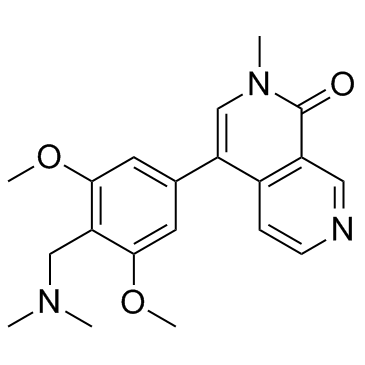| Description |
BI-7273 is a selective, and cell-permeable BRD9 inhibitor, with an IC50 and a Kd of 19 and 0.75 nM; also shows high effect on BRD7, with an IC50 and a Kd of 117 nM and 0.3 nM.
|
| Related Catalog |
|
| Target |
IC50: 19 nM (BRD9), 117 nM (BRD7)[1] Kd: 0.75 nM (BRD9), 0.3 nM (BRD7)[1]
|
| In Vitro |
BI-7273 is a selective, and cell-permeable BRD9 inhibitor, with an IC50 and a Kd of 19 and 0.75 nM; also shows high effect on BRD7, with an IC50 and a Kd of 117 nM and 0.3 nM. BI-7273 also has slight activity against a panel of kinases such as CECR2, BRPF1, BRD1, CREBBP, EP300, FALZ, TAF1(2) and TAF1L(2), with Kds of 8.8 nM, 210 nM, 2600 nM, 8600 nM, 10000 nM, 850 nM, 1000 nM, and 1200 nM, respectively. BI-7273 (1 μM) is active in U2OS cell lines. BI-7273 blocks EOL-1 cell proliferation with EC50 of 1400 nM[1].
|
| Kinase Assay |
His-tagged BRD9 is immobilized to a density of 2000-4000 RUs on flow cells 3 and 4 of a Biacore NTA-chip. Carbonic anhydrase II is immobilized at a similar density on flow cell 2 and a blank reference surface is generated on flow cell 1. The buffer is then switched to assay buffer (HBS-P+ = 10 mM HEPES, pH 7.4, 150 mM NaCl, 0.05 % P20 + 5 % DMSO) and the chip equilibrated for several hours before use for Kd determinations. To be able to correct for differences in bulk solvent refractive index caused by small variations in the DMSO concentration solvent correction samples are included at the beginning and end of the run. Compounds (BI-7273, etc.) are injected in concentration series (1:1 dilutions, 7 different concentrations), starting with a maximum concentration that is approximately 10-20-fold higher than the expected Kd. The concentration series are prepared in 96-well plates. In the case that the dilution window chosen for a particular compound does not appropriately bracket the Kd of the compound the measurement is repeated with an optimized starting concentration. Positive and negative control samples are included at regular intervals to be able to monitor the performance of the assay. CBS is used as a positive control for carbonic anhydrase II to check for integrity of the reference protein at regular intervals. To correct for the excluded volume effect a DMSO calibration series is prepared and the calibration samples are measured at the beginning and end of each run. Kd values are determined and averaged[1].
|
| Cell Assay |
Cells are grown in 50 µL medium for 7 days starting with 500 and with 1000 cells per well of a 384 well plate in the presence of varying concentrations of compound (BI-7273, etc.) before measuring viability via cellular ATP levels using the cell titer glow assay[1].
|
| References |
[1]. Martin LJ, et al. Structure-Based Design of an in Vivo Active Selective BRD9 Inhibitor. J Med Chem. 2016 May 26;59(10):4462-75.
|
